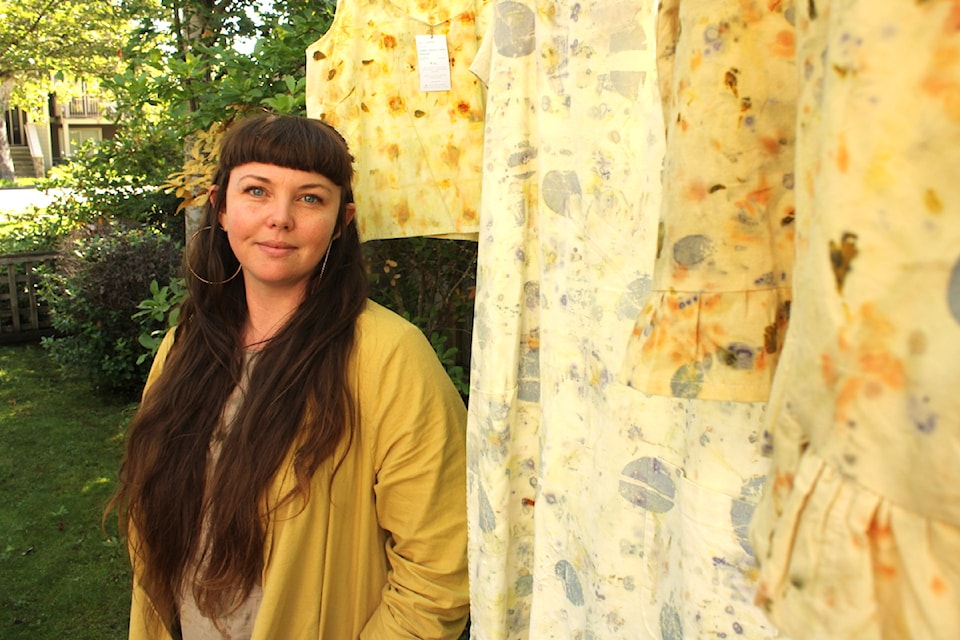With large pots steaming away on her Victoria apartment's patio, Carly Stefanowich takes flower petals freshly plucked from nearby planters and intuitively arranges across a sheet of linen.
The piece of cloth then gets rolled into a tightly-packed burrito shape and lowered into the steam bath where a mixture of heat, moisture and pressure extracts the flowers' purple and yellow hues to imprint them into the fabric.
Stefanowich has been using the natural dyeing process for years to craft her clothing line, which uses secondhand fabrics sourced from around Victoria. The local focus of her company, Lorelei Textile Design, goes even further as her eco-printing technique utilizes the region's nature to infuse her products with colour.
“Eco-printing is 100 per cent for me, I make the clothing because I love to do the dyeing,” Stefanowich said as the morning sun gleamed into her patio workspace. “It’s a joyful process, I just find it really, really meditative.”
It's also a practice that's connected the designer to her surroundings as the garments are fashioned with whatever foliage is available at the time. That sees Stefanowich taking advantage of bountiful flowers in the summer before she turns to the abundance of leaves in the colder months.
"I feel a lot more in-tuned with my local environment and the seasons. I think that translates into something that makes me feel more grounded as well," she said.
The entrepreneur who hand sews all her items said her inspiration for getting into clothing design likely came from her mom – an avid thifter who would use her amazing sewing skills to make her children homemade winter coats and other items.
With steep fabric costs being a barrier when she first started out, Stefanowich's solution was using upcycling linen bed sheets for her all her material needs. Years later, she's still using the salvaged sheets as it helps keep her prices accessible to customers and she gets to make high-quality pieces out of what would've been wasted fabric.
She also offers some lower-priced items by eco-printing some ready-to-wear thrifted clothes.
“Accessibility is something that really matters to me. People who don’t have a lot of money deserve to wear cool things too.”
Stefanowich became increasingly passionate about creating naturally dyed products with locally sourced materials as she learned more about the fashion industry's impact on workers and the planet. She said the materials used in most new clothing are produced, dyed and sewn in different parts of the world, resulting in a lot of transportation emissions before the items even get shipped to stores.
Clothing supply chains also use dye houses in places with lax safety regulations for workers who are handling synthetic dyes, Stefanowich said. Those colouring dyes are usually petrochemical-based, often containing benzene and other substances that can be harmful to people and the planet.
“The way that I wanted to produce clothing was something that aligned with my values and something that was really regionally specific,” she says.
She hopes operations like the one on her patio can spur a mini-revolution that pushes for more sustainable clothing. The designer also runs local workshops about once a month on upcycling, eco-printing and more as she aims to empower attendees to start taking small actions for the Earth.
Despite working with natural dyes for more than a decade, she still learns something new about the craft every day. Some of her favourite plants to work with include smoke bush, which leaves stunning blue leaf prints, and Coreopsis as it's colours bleed defined flower shapes into the linen.
As a mainstay at local markets, Stefanowich enjoys hearing the emphatic gasps of people seeing her pieces for the first time. There's usually many market-goers curious about how eco-printing works.
"A lot of people think I'm some kind of plant witch, they're like 'I don't know how you do this,'" she said with a laugh, noting others can immediately spot the kind of plant used.
The business owner has a lot of repeat customers and she often hears from people who are still wearing one of her pieces they bought years ago.
"That makes me feel like I'm putting something good out to the world that will last as well."



